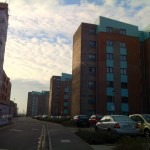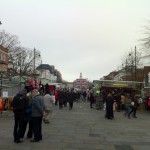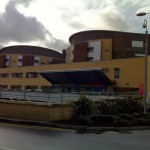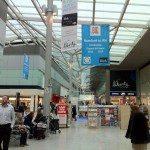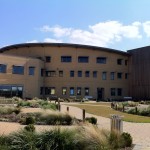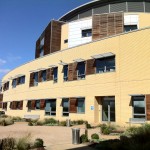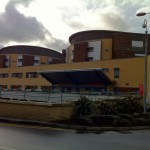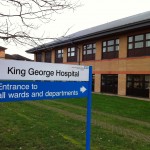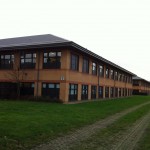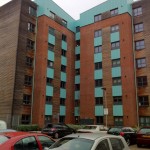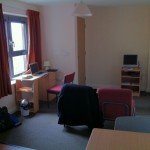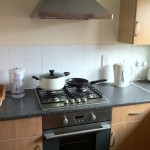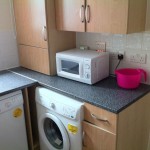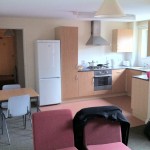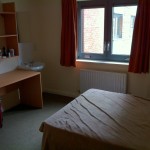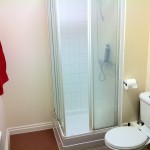Romford
GUIDE TO AUC: ROMFORD
About Romford
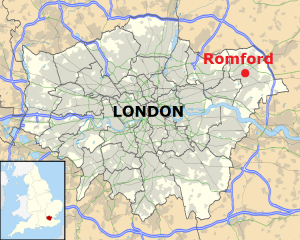
Romford is located in the northeastern corner of London, England. It is the administrative seat of the borough of Havering, one of the 32 boroughs that make up London. The environment is generally suburban but with a vibrant city center with lots of shopping and restaurants. Romford is about 20-30 minutes from central London (London Liverpool Street Station) by train, depending on the train.
AUC students can rotate in Medicine, Pediatrics, OB/Gyn, as well as Surgery here. Students rotate at either Queen’s Hospital, or its nearby sister hospital, King George Hospital (or both). King George Hospital is an older, smaller hospital, while Queen’s Hospital is a newer, larger hospital, built in 2006. There is a free hospital shuttle bus that goes between the two locations every hour between 7:30am to 6:50pm, and the ride takes 20 minutes.
At Romford, students have a very flexible schedule (much more than most other AUC-affiliated hospitals) and can choose to do rotations at several different specialties of their choice. Because of this, you have the opportunities to see and do a lot, and tailor your education to what you want. Queen’s Hospital and King George Hospitals are both major teaching hospitals and AUC students will rotate with UK medical students from Barts University and other medical schools in London. AUC students also work with medical teams that include attendings (consultants), residents (house officers), and fellows (registrars).
While most students will be assigned to either Queen’s or King George’s Hospitals to do rotations, in reality, most students will go to both, as different sub-specialties/procedures are done at each hospital. For example, when I did surgery there, you can decide to do a week of vascular surgery or ENT surgery, both of which are at Queen’s, and then decide you want to do a week of urology or breast surgery, which are only at King George’s. Your attending may even be at different hospitals on different days. So although you may be assigned to one hospital or the other, most likely you’ll be experiencing both.
Getting in
Most students who come to Romford fly into Heathrow International Airport, located on the west side of London on the opposite side of the city. Unless you wanted to give a generous required donation of nearly US$200 to the cab driver, DON’T TAKE THE CAB to Romford from Heathrow! It is too far to be affordable by cab!
Instead, I recommend buying an oyster card when you first exit the airport into the Tube (London Underground) station. I’d recommend getting the pay-as-you-go card. The best thing about the card is if you happen to take the train too frequently that day, the card will cap it so that you’ll only be charged the max amount that you would as if you were to buy an all-you-can-ride day pass. A train ride from Heathrow airport to Romford will cost only 8 lbs (about US$11), and take about 2 hours.
From Heathrow, take the Piccadilly line (blue line) heading east. Take it all the way to Holborn. At Holborn Station, transfer to the Central line (red line), then get off at London Liverpool Street Station. After exiting the London Underground (the “Tube”) through the turnstiles, you’ll find yourself at the National Rail station (or follow the signs for the National Rail). Look at the big screens above that show the train schedules and platforms. On the screen, look for the Greater Anglia trains that call at (stop at) Romford, and take a note of the time and platform of departure. Find the platform, going through another set of turnstiles, then get on the train. Take the train all the way to Romford Station. From Romford Station, the Hospital and Swan Housing are both around 10 minutes away by walking.
Accomodations
As Queen’s Hospital and King George Hospital are located on opposite sides of Romford (20 minutes apart by bus), most students stay either around King George Hospital or Queen’s Hospital, depending on which hospital you are scheduled to spend more of your time at (although in reality, most students travel back and forth between both during their rotations).
QUEEN’S HOSPITAL ACCOMODATIONS:
For Queen’s Hospital, most students stay at Swan Housing on Union Road. Before you go to the UK, contact the accomodation officer at Swan to reserve a spot. They have studio flats, single bedroom apartments, two-bedroom apartments, as well as shared suites. They take reservation 17 days prior to arrival. Swan Housing was built mainly as hospital staff housing. They were opened in 2009, and so the lodging is fairly new. Swan Housing is within walking distance from Queen’s Hospital and the shopping areas of Romford. You should receive their contact information from the school when you schedule your rotation. However, just in case you don’t, here is their contact info as per January 2013:
- Aimee Marler: 01277 314 359 – amarler@swan.org.uk
- Shah Uddin: 01277 314 360 – suddin@swan.org.uk
Here are their prices as per January 2013. Water, gas, and electricity are all included in the price. Council tax is not included. If you are living in a unit with non-students, you may have to pay council tax. If you are a student and live either alone or solely with other students, you can call the London Borough of Havering town hall (Romford’s town hall) to request to be exempted from paying council tax. For updated prices, I would contact them directly, as the information I have here may be outdated since I left Romford.
- Studio Flat £678.86 pcm
- 1 Bed Flat £818.55 pcm
- 2 Bed Flat £954.14 pcm
- 4 Bed Suite (with individual bathrooms) £452.77 pcm
- 4 Bed Suite (with shared bathroom) £420.95 pcm
- 3 Bed Suite (with individual bathrooms) £461.67 pcm
- 2 Bed Suite (with individual bathrooms) £569.35 pcm
Although you technically sign for a 6 month agreement, you can tell them one month in advance that you will be moving out without any penalty charges. They are used to students staying only a few months or so. Rent is paid in the beginning of every month.
KING GEORGE HOSPITAL ACCOMODATIONS:
If you are scheduled to do rotations at King George’s Hospital, then you can also stay in accomodations on King George hospital grounds, called Opus Accomodations. Here are their prices as per January 2013:
- 4 bed (shared) £415.75 per unit
This price includes council tax and service charges. Contact these emails below for more information:
Here are some photos of my one-bedroom flat at Swan Housing:
Living
- Grocery: There are lots of grocery stores in Romford. Sainsbury is the closest grocery store. It is very large and has a cafeteria inside that sells cooked foods at good prices. Sainsbury is located in a shopping plaza called The Brewery, which also includes home improvement stores, restaurants, a movie theater, pharmacy, and more. Other grocery stores include ASDA (which is owned by WalMart), Iceland, Lidl, and Tesco Express. Lidl is located on South Street right behind Fitness First and is probably the cheapest grocery store in town.
- Shopping: There is lots of shopping in Romford, within walking distance of the hospital and Swan Housing. The Brewery is the closest shopping plaza, and adjacent to it there is South Street (a pedestrian shopping street), Romford Market (an outdoor market), as well as the Liberty Mall.
- Cafes: There are many cafes in Romford, including two Starbucks and several Costa Coffee locations. The Starbucks are located on South Street and inside the Liberty Mall. There is a Costa Coffee in The Brewery as well as one on South Street. Both offer free wifi.
- Gym: There are three gyms around town: Virgin Active, Fitness First, and Lion’s Den Gym (LDG). Virgin Active is the largest but most expensive, at around 80 lbs per month. It has a weight room, treadmills, cafe, lots of classes, and an indoor swimming pool. The facilities are really new and clean. LDG is the smallest but cheapest, around 35 lbs per month. LDG is grungy and mainly geared towards mixed martial arts, boxing, and weight lifting, although they do have some treadmills as well. The majority of the clientele at LDG are guys.
- Bank: If you have Bank of America, you can withdraw from Barclay’s Bank without any international fees. The closest Barclay’s is on South Street.
- Phone: Bring an unlocked phone. You can “buy” a pre-paid SIM card from Carphone Warehouse in The Brewery. I put “buy” in quotations because the SIM card is technically free and you just put money on the card that goes towards your calls. I recommend getting a “3” SIM card (yes, Three is the name of the company!). 3 coverage is very extensive and it is also the only company I found that has a package that gives you 2000 texts, 200 minutes, and unlimited data for 30 days for only 15 lbs. If you tether your phone, you can also use that data to get internet on your computer, giving you computer internet access anywhere you travel in the UK. There is no need for buying a separate dongle. It’s not as fast as cable internet however, and you won’t be able to download files at high speeds or watch YouTube videos at an uninterrupted pace.
- Internet: You can get pay-per-month internet access if you are living at Swan Housing, but it’s through a company called Sky.
Amenities
Queen’s Hospital has several amenities:
- Cafeteria: The cafeteria is located in the main entrance atrium. As students, we get discounts. There is also a cafe and a convenient store with to-go sandwiches.
- Medical Library: Located in the Education Center, the library is a great place to study.
- Education Center: Located just off the main atrium, this is where we go for registration, orientation, lectures, grand rounds, AUC meetings, and small group teaching sessions. The medical library is located here, as well as simulation labs.
- Lavender Garden: This is a nice garden on the hospital grounds where you can go to get some fresh air.
What to Bring:
- International Power converter. They use 230V 50 Hz, with three prongs.

- If you are a guy, bring button-up shirts, slacks, and comfortable flat shoes. You don’t need scrubs, white coats or neckties! If you are doing surgery, scrubs and crocs will be provided in the locker rooms. If you don’t prefer wearing other people’s crocs, it may be a good idea to bring your own.
- Stethoscope
- Passport
- IMPORTANT!!!! Bring your letter from the school confirming that you are doing rotations at Romford! If not, you may not be allowed to enter the country at customs. If you plan on traveling outside of the UK during your rotation, have this letter with you at all times.
Getting Out
There’s tons to explore in Romford, London, the UK, and Europe. Here are some places to check out in Romford:
- Shopping! — Like I mentioned above, there’s lots of shopping in Romford. Check out the historical Romford Market, which goes on every Wednesdays, Fridays, and Saturdays of the week. It is located where High Street meets South Street. There is also South Street, a pedestrianized shopping street that runs through the middle of town. Liberty Mall and The Brewery are also nearby.
- Bowling — If you like bowling, there is an arcade/fun center upstairs in The Brewery that has bowling, arcade games, air hockey and lots more.
- Ice Skating — Right next to Queen’s Hospital there is an ice skating rink.
- Movies — There is a large movie theater upstairs inside The Brewery.
Here are some places to check out in the rest of London. While a lot of museums lot of museums like the British Museum or the Museum of Natural History is free, a lot of other attractions like the Tower of London or London Eye have entrance fees. I’d recommend taking advantage of the London 2-for-1 deals if you plan on going to these.
- Westfield Mall in Stratford — Just a few stops away by train, this mall is one of Europe’s largest malls and was built for the 2012 Olympics. It’s really nice and new inside and out.
- Camden Market — Built along the old Camden locks, Camden Market is one of the largest markets I’ve been, filling the entire district of Camden. You can find everything here, from clothes to trinkets to tattoos to food. Camden is the center of the punk scene (and anything non-mainstream) in London. Some notable things to check out: ice cream made by liquid nitrogen, and the futuristic beat-blasting wonderland store called Cyberdog.
- Borough Market — When it comes to food stalls, this is the best place for it. Located downtown, south of the Thames River, you can find all sorts of great eats, from duck sandwiches, to mulled wine, to mushroom pate. Who says British food is bland?? Not me, and especially not after visiting this market.
- Sights and Sounds of central London — Take a walk along the Thames and you can see the Tower Bridge, Tower of London, London Bridge, Big Ben, Parliament, St. Paul’s Cathedral, the London Eye, Millenium Bridge, Tate Modern, Shakespeare’s Globe Theater, and all the famous landmarks that people come to London to see.
- Piccadilly Circus/Leicester Square/Chinatown area — Piccadilly Circus is the Times Square of London. It’s packed, it’s lively, and it’s especially cool to see at night, with all the lights and people. There are tons of shows you can watch, and there are some odd museums and stores like Ripley’s Believe it or not, or the M&M store. For great food, Chinatown is right around the corner.
- Wellcome Museum — This peculiarly fascinating museum was started by a doctor, and its collections merge the art of medicine with history, culture, and technology. The museum is free and well worth the trip into town to see, especially for us med students.
- British Museum — If you love world cultures, art, and history, you’ll love the British museum. It has an extensive collection of artifacts from around the world. Their Egyptian collection is particularly well-known, and the Rosetta Stone is here. The museum is free to enter, and can take days to go through.
- Old Operation Theater Museum — If you come to Romford for your surgery rotation, this museum may be worth checking out to better understand the history of surgery. Like the name suggests, you see an original, preserved OR from back in the old days when surgeries were performed on a stage for spectators to watch. You also see lots of old surgical tools, many of them quite gruesome and barbaric, used back in the days.
- St. Paul’s Cathedral and Westminster Abbey — St. Paul’s Cathedral is the largest cathedral in London. Westminster Abbey is primarily used by the royal family for ceremonies, and serves as a burial ground for the famous individuals in British history. Both are beautiful, historical cathedrals, with amazing architecture, and both require expensive admission fees to enter during the daytime. However if you don’t want to pay the entrance fees, I highly recommend going during their daily Evensong services, which happen during the evenings, and open to anyone to attend for free, no matter what faith you are. These services consist of prayers entirely sung by a choir, and the cathedrals have some amazing acoustics. Regardless of your religious backgrounds, the Evensong services can be beautiful and inspirational to anyone.
London is a great jumping-off point to explore the rest of Europe, and many students take advantage of this location to take some weekend trips. If you want to go to France, Belgium, or the Netherlands, you could consider taking the Eurostar high speed train that goes underneath the English Channel. A trip to either Paris or Brussels will take around 2 hours from London. The train departs from London St. Pancras station, but in order to get affordable deals, you must book well in advance. If you wanted to fly, many students look on EasyJet or RyanAir for cheap flights. London has several of airports to depart from, including Heathrow, Southend, Gatwick, Luton, and Stansted airports.
Surgery
Queen’s Hospital is a popular place to do surgery rotations.
If you are coming for surgery, you can do Lower GI, Upper GI, Vascular, Trauma and Orthopedics, ENT, Breast (at King George Hospital), Urology (King George Hospital), and/or Neurosurgery.

